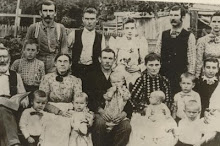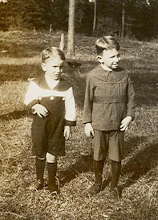THE STORY OF ROBERT H. DENNARD
WRITTEN BY TERESA DENNARD and ROBERT H. DENNARD
EDITED WITH ADDITIONAL MATERIAL BY FRED HOLLAND.
 |
| With Parents Lois (Heath) and Bufford L. |
|
Robert Dennard was born in Terrell, a small town in Texas in 1932, in the middle of the Great Depression to a loving family of very modest means, but great pride. By the time he was growing up, the family moved to a small farm in Clayton, a rural area in East Texas. They lived in a house that did not yet have electricity. His father farmed the fields and raised the livestock, while his mother kept them fed and provided with clean clothes. He started his education in a one room schoolhouse with three grades in different rows of desks. After a couple of years he moved to a little larger school where his
fourth grade class was in the same room with a fifth grade class.
Learning came easily to him, so he had a chance to hear what the higher
grades were doing and advance at his own pace.
"In the class photo I am directly behind Jerri Rayburn, the smallest boy on the back row. I started school about the time of my sixth birthday (9/5/32), barely six years old, on the same day as Jerri who was my next door neighbor. There were three classes there, and I suspect this was my first year. I completed the three grades in two years and remained among the youngest and smallest all through high school. It came in handy having a bigger, older brother like James at times."
 |
Front row ??? in White Dress, Juanita Wedgeworth (now Clinton) in the middle and Jerri Rayburn (now ?) in the dark dress. Back row from left to right 1 ?, 2 ?, 3 ?, 4 ?, 5. Robert H. Dennard, 6 ?
[I would appreciate help naming the rest of this group - fredddallas@gmail.com ] |
His older sisters, Evangeline (Holland) and Jessie Jo (Wedgeworth) and brother, James (J.C.), had grown up and left home, but they visited frequently and provided great role-models. “I remember long summers with a lot of free time to think and entertain myself.”
In the early 1940’s when World War II came, his father saw an opportunity to move the family to Irving, a small town just outside Dallas. Dennard now attended bigger schools and lived in a community where he could visit and interact with classmates. He also found the library and became an avid reader.
 |
| With Sisters, Evangeline (Holland) and Jessie Jo (Wedgeworth) |
 |
| With siblings, Jessie Jo (Wedgeworth) and James (J.C.) |
When his sister Evangeline went away to become an Army nurse, she left behind her collection of books and phonograph records. “I was totally impressed with a large red book which was an anthology of science fiction short stories,” recalls Dennard. “I read them all with pleasure, and I particularly enjoyed those by H.G. Wells which stimulated my young imagination and formed vivid images of strange worlds and people. I was very amused by a book of Ogden Nash poems that I read and memorized. There was also an album of Sigmund Romberg operettas that fascinated me. I sang along with them and also memorized the words and tunes. This most likely was the starting point for my love of choral singing and all forms of music.”
While Dennard loved sports and played baseball and touch football with his friends, he was not big enough or fast enough to compete in high school team sports. Luckily in his sophomore year a high school band was started and he became a member, Playing French horn at first, he later switched to a bass horn that was needed in the marching band. As he was finishing high school, Dennard chose his future career as an electrical engineer with the help of a guidance counselor. “She advised me that electrical engineering was a fast-growing field and said it would be good for me because of my mathematics aptitude and my interest in science. I planned to go to a nearby state junior college along with many friends.”
 |
| In his band uniform Southern Methodist University |
One day something important happened that changed his life. The band director at Southern Methodist University in Dallas came to visit and offered Dennard a band scholarship to attend a much better school. His advice was “Why not take the best opportunity available to you?” “That was a striking idea to me that helped guide the rest of my life.” It helped him go on from SMU to Carnegie Institute of Technology in Pittsburgh, a top engineering school that is now Carnegie Mellon University. From there he did not hesitate when he got an opportunity to join IBM and its newly opened Thomas J. Watson Research Center.
 |
| IBM Thomas J. Watson Research Center |
After a learning period in research, he felt very lucky to be involved in microelectronics in the middle of the 1960’s.
Dennard’s primary work was in MOS (metal-oxide semiconductor) transistors and integrated digital circuits using them.
In 1967 he invented the dynamic RAM (DRAM) memory cell used universally in computers today. With coworkers he developed the concept of MOS transistor scaling in 1972, which is often cited as a guiding principle for microelectronics. The simplicity, low cost and low power consumption of DRAM (dee-RAM) when combined with the first low-cost microprocessors, opened the door to small personal computers. Today, every PC, notebook computer, game console and other computing device is loaded with DRAM chips. Dr. Robert H. Dennard was appointed an IBM Fellow in 1979. He holds 65 U.S. patents and has published over 100 technical papers. He has received many honors including the
National Medal of Technology from President Reagan in 1988 and induction into the National Inventors Hall of Fame in 1997. In 2009 he was awarded the
Charles Stark Draper Prize by the National Academy of Engineering and the IEEE Medal of Honor.
 |
| Wearing the Kyoto Prize Medal for Advanced Technology |
Most recently he has been awarded the prestigious Kyoto Prize for Advanced Technology, which is equivalent to the Nobel Prize.
Hear Dr. Dennard's presentation of the 2013 Kyoto Prize Commemorative Lecture
At age 82, Robert still goes in to work at the Research Center. He and
his wife, Jane, live in New York and enjoy walking their two Scottish
terriers in a beautiful park on the edge of the river in
Croton-on-Hudson. They sing with the Taghkanic Chorale in Westchester
County, a group that sings Beethoven, Schubert and Mendelssohn pieces.
The Dennards also enjoy Scottish Country Dancing every week at classes
sponsored by Westchester Scottish Country Dance Society in Elmsford.
 |
Check out:
Dr. Robert Heath Dennard invented the basic structure of Dynamic Random Access Memory (DRAM), which is now extensively utilized as one of integrated circuit (IC) memory systems. His innovation has immensely increased the capacity of digital information storage, leading to dramatic progress in information and telecommunications technology. Dr. Dennard and his colleagues also proposed guidelines, called “scaling theory”, to miniaturize field-effect transistors, which play key roles in most ICs, including DRAM, thereby promoting the amazing advance in IC technology.
My husband’s uncle Robert is a modest, unassuming man. He once explained to me that he didn’t really invent DRAM. “We just figured out the physics for something that already existed as part of the natural world, then engineered a way to put it to use,” he said as if that was somehow less impressive than “inventing” it.
When he and his wife Jane went to Japan to receive the prize, he didn’t talk much about the honor or the money (there’s a gold medal and 50 million yen – about half a million U.S. dollars — in prize money). Instead, he marvelled about being able to dance with his beautiful wife to the music of a wonderful orchestra, on a dance floor they had to themselves. He send his nieces and nephews photos of “Uncle Robert and Aunt Jane” dancing together. ... more click here.
Robert H. Dennard remarks...
|
“I often wake up in the middle of the night with a solution to a problem that I have been working on previously. Many inventors have described similar experiences to me, including getting out of bed to make notes or drawings before going back to sleep. Others have described significant inventions made while driving, which apparently leaves a lot of the mind free, at least before cell phones. My invention of the DRAM memory cell came early one evening after I came home stimulated and challenged from listening to a talk about a competing research project. The basic idea came in a moment, but there were a couple of months of perfecting it before the final simplification to a single transistor came in another flash of inspiration. At a
National Inventors Hall of Fame event, while I was talking with four other inductees, I discovered that all five of us were raised in rural areas or small towns, and most started their education in one-room schoolhouses. We all were left on our own a lot with plenty of free time to develop our ideas about life. Now that may not be the key to our subsequent successes, but it surely is a counter argument to many of the things that are considered necessary for the younger generation today. I developed a very slow thinking process in my early days, and I believe that is why I am able to bring great concentration to a problem and engage my whole brain in finding a creative solution. ” ...
 |
| Check out: Dr. Robert H. Dennard, IBM Fellow, beside his drawing of a DRAM cell (circuit schematic) |
|
“I am very proud to say that with many process improvements, structural innovations, and plain hard work, the thousands of people who make up this industry have been able to achieve in forty years a reduction in all dimensions of integrated circuits by a factor of about one hundred fifty, and more is still expected. The results of that, the ways that computers have advanced and changed our lives have been truly amazing." ...
"Can you imagine that I used a slide rule to design my first memory chip? The point of bringing that up is to ask the question, what will the world be like in another forty years? This is the challenge and the opportunity for young people today who are just starting their careers. The questions there are not how far they can go, but how far should they go."













